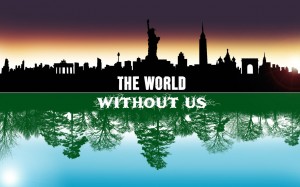This week, we embark on a thought experiment: what would happen if humans suddenly disappeared from the Earth? This journey into the improbable (but intriguing) disappearance of humans is inspired by Alan Weisman’s book “The World Without Us”. What legacy would our species leave behind? How long would our footprint on Earth’s surface last? What will be the long-term effects of our brief (but dominant) time on this planet?
We will focus our exploration on two particular chapters: Chapter 3 (“The City Without Us”) and Chapter 9 (“Polymers Are Forever”). The former explores the fate of New York City, while the latter explores the fate of plastics in the environment. In my mind, these two chapters do an excellent job of highlighting both the fragility of human civilization (you’ll be amazed at how fast New York falls apart) and the long-term environmental consequences of our species (plastics, in particular, will last well into the geological future).

Pingback: The Anthropocene @ the University of Vermont - GeoCritique·
In Chapter 3 of Alan Weisman’s The World Without Us, entitled “The City Without Us,” we are taken through a narrative of the most iconic city in the United States after human inhabitants, who populated, maintained, and once controlled it, have seized to exist in the world. A theme or concern that has come up repeatedly in this course has been reconciling the term “Anthropocene” with its inherent anthropocentrism, which in my mind partly asks that if humans were to become extinct, would the current geologic epoch still be characterized and defined by this human impact?
This chapter struck me because it seems to give two different answers that share a vital point. Before posing these two sides, what I felt was common to both was the central thesis in Nigel Clark’s Inhuman Nature – that there exists a nature over which we do not have dominion. A nature that will overtake the structures we have constructed for human use, since, in the first place, it gave us the material to build these objects, and will ultimately deteriorate with time. For Weisman, this nature comes in the form of smaller-scale ecological processes like bacteria that will feed off of the fossil fuels that have burst out of rusted petroleum containers, but also in larger scales (in both time and space) where he suggests that glaciers will flatten the city like a natural bulldozer, as it has done for the past 100,000 years.
The first side of his argument is composed of ecological consequences that are obvious to us now: flooding in the underground rail tunnels, foreign and invasive species transported by centuries of trade, automotive and factory pollution weakening the Hemlock Forest in the New York Botanical Garden – these all make for an interesting narrative about how our physical infrastructure will interact with ecological forces immediately following our departure. I also sensed that in this more immediate time period, there’s a stronger argument for both characterizing the period as the Anthropocene, and doing so without seeming anthropocentric. Here, in a world without humans, our impacts still continue to change ecologies, dictate the surface of the land, and determine what types of life continue or discontinue (see this passage: “Long before, the wild predators finished off the last descendants of pet dogs, but a wily population of feral house cats persists, feeding on starlings” (37)). Though we do not exist anymore, our legacy continues to impact natural systems.
The second side is not quite as elaborated on as the first, but is responsible for the ominous ending to the chapter. Here, long term geological processes, over the course of hundreds of thousands of years, shape what once was New York City, until all that remains of the Statue of Liberty, various pipes, and wiring harnesses is an “unnatural concentration of a reddish metal” (38). Not even those pests that we think are able to survive unconditionally will continue: “The seemingly invincible cockroach, a tropical import, long ago froze in unheated apartment buildings. Without garbage, rats starved or became lunch for the raptors nesting in burnt-out sky-skrapers” (36). This is a counterpoint to the very human-influenced ecology of the Manhattan just after we leave. This is the larger nature that Nigel Clark would like us to think about: total indifference and lack of concern for our being. I’m not sure if I created this dichotomy out of thin air, or even how I find myself thinking about these two sides, but like Lee suggested in her questions, even the legacy of the Anthropocene might not last forever.
Great post really, engaged my full interest.
Pingback: Bumi (Tanpa) Manusia |·